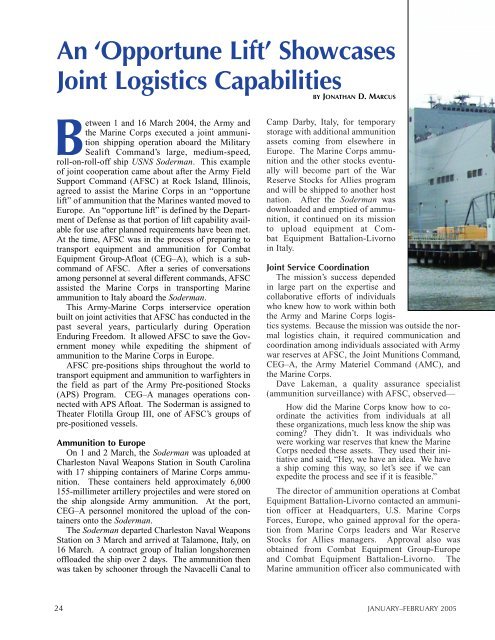Supporting the First Stryker Brigade in Iraq - Army Logistics ...
Supporting the First Stryker Brigade in Iraq - Army Logistics ...
Supporting the First Stryker Brigade in Iraq - Army Logistics ...
You also want an ePaper? Increase the reach of your titles
YUMPU automatically turns print PDFs into web optimized ePapers that Google loves.
An ‘Opportune Lift’ Showcases<br />
Jo<strong>in</strong>t <strong>Logistics</strong> Capabilities<br />
BY JONATHAN D. MARCUS<br />
Between 1 and 16 March 2004, <strong>the</strong> <strong>Army</strong> and<br />
<strong>the</strong> Mar<strong>in</strong>e Corps executed a jo<strong>in</strong>t ammunition<br />
shipp<strong>in</strong>g operation aboard <strong>the</strong> Military<br />
Sealift Command’s large, medium-speed,<br />
roll-on-roll-off ship USNS Soderman. This example<br />
of jo<strong>in</strong>t cooperation came about after <strong>the</strong> <strong>Army</strong> Field<br />
Support Command (AFSC) at Rock Island, Ill<strong>in</strong>ois,<br />
agreed to assist <strong>the</strong> Mar<strong>in</strong>e Corps <strong>in</strong> an “opportune<br />
lift” of ammunition that <strong>the</strong> Mar<strong>in</strong>es wanted moved to<br />
Europe. An “opportune lift” is def<strong>in</strong>ed by <strong>the</strong> Department<br />
of Defense as that portion of lift capability available<br />
for use after planned requirements have been met.<br />
At <strong>the</strong> time, AFSC was <strong>in</strong> <strong>the</strong> process of prepar<strong>in</strong>g to<br />
transport equipment and ammunition for Combat<br />
Equipment Group-Afloat (CEG–A), which is a subcommand<br />
of AFSC. After a series of conversations<br />
among personnel at several different commands, AFSC<br />
assisted <strong>the</strong> Mar<strong>in</strong>e Corps <strong>in</strong> transport<strong>in</strong>g Mar<strong>in</strong>e<br />
ammunition to Italy aboard <strong>the</strong> Soderman.<br />
This <strong>Army</strong>-Mar<strong>in</strong>e Corps <strong>in</strong>terservice operation<br />
built on jo<strong>in</strong>t activities that AFSC has conducted <strong>in</strong> <strong>the</strong><br />
past several years, particularly dur<strong>in</strong>g Operation<br />
Endur<strong>in</strong>g Freedom. It allowed AFSC to save <strong>the</strong> Government<br />
money while expedit<strong>in</strong>g <strong>the</strong> shipment of<br />
ammunition to <strong>the</strong> Mar<strong>in</strong>e Corps <strong>in</strong> Europe.<br />
AFSC pre-positions ships throughout <strong>the</strong> world to<br />
transport equipment and ammunition to warfighters <strong>in</strong><br />
<strong>the</strong> field as part of <strong>the</strong> <strong>Army</strong> Pre-positioned Stocks<br />
(APS) Program. CEG–A manages operations connected<br />
with APS Afloat. The Soderman is assigned to<br />
Theater Flotilla Group III, one of AFSC’s groups of<br />
pre-positioned vessels.<br />
Ammunition to Europe<br />
On 1 and 2 March, <strong>the</strong> Soderman was uploaded at<br />
Charleston Naval Weapons Station <strong>in</strong> South Carol<strong>in</strong>a<br />
with 17 shipp<strong>in</strong>g conta<strong>in</strong>ers of Mar<strong>in</strong>e Corps ammunition.<br />
These conta<strong>in</strong>ers held approximately 6,000<br />
155-millimeter artillery projectiles and were stored on<br />
<strong>the</strong> ship alongside <strong>Army</strong> ammunition. At <strong>the</strong> port,<br />
CEG–A personnel monitored <strong>the</strong> upload of <strong>the</strong> conta<strong>in</strong>ers<br />
onto <strong>the</strong> Soderman.<br />
The Soderman departed Charleston Naval Weapons<br />
Station on 3 March and arrived at Talamone, Italy, on<br />
16 March. A contract group of Italian longshoremen<br />
offloaded <strong>the</strong> ship over 2 days. The ammunition <strong>the</strong>n<br />
was taken by schooner through <strong>the</strong> Navacelli Canal to<br />
24<br />
Camp Darby, Italy, for temporary<br />
storage with additional ammunition<br />
assets com<strong>in</strong>g from elsewhere <strong>in</strong><br />
Europe. The Mar<strong>in</strong>e Corps ammunition<br />
and <strong>the</strong> o<strong>the</strong>r stocks eventually<br />
will become part of <strong>the</strong> War<br />
Reserve Stocks for Allies program<br />
and will be shipped to ano<strong>the</strong>r host<br />
nation. After <strong>the</strong> Soderman was<br />
downloaded and emptied of ammunition,<br />
it cont<strong>in</strong>ued on its mission<br />
to upload equipment at Combat<br />
Equipment Battalion-Livorno<br />
<strong>in</strong> Italy.<br />
Jo<strong>in</strong>t Service Coord<strong>in</strong>ation<br />
The mission’s success depended<br />
<strong>in</strong> large part on <strong>the</strong> expertise and<br />
collaborative efforts of <strong>in</strong>dividuals<br />
who knew how to work with<strong>in</strong> both<br />
<strong>the</strong> <strong>Army</strong> and Mar<strong>in</strong>e Corps logistics<br />
systems. Because <strong>the</strong> mission was outside <strong>the</strong> normal<br />
logistics cha<strong>in</strong>, it required communication and<br />
coord<strong>in</strong>ation among <strong>in</strong>dividuals associated with <strong>Army</strong><br />
war reserves at AFSC, <strong>the</strong> Jo<strong>in</strong>t Munitions Command,<br />
CEG–A, <strong>the</strong> <strong>Army</strong> Materiel Command (AMC), and<br />
<strong>the</strong> Mar<strong>in</strong>e Corps.<br />
Dave Lakeman, a quality assurance specialist<br />
(ammunition surveillance) with AFSC, observed—<br />
How did <strong>the</strong> Mar<strong>in</strong>e Corps know how to coord<strong>in</strong>ate<br />
<strong>the</strong> activities from <strong>in</strong>dividuals at all<br />
<strong>the</strong>se organizations, much less know <strong>the</strong> ship was<br />
com<strong>in</strong>g? They didn’t. It was <strong>in</strong>dividuals who<br />
were work<strong>in</strong>g war reserves that knew <strong>the</strong> Mar<strong>in</strong>e<br />
Corps needed <strong>the</strong>se assets. They used <strong>the</strong>ir <strong>in</strong>itiative<br />
and said, “Hey, we have an idea. We have<br />
a ship com<strong>in</strong>g this way, so let’s see if we can<br />
expedite <strong>the</strong> process and see if it is feasible.”<br />
The director of ammunition operations at Combat<br />
Equipment Battalion-Livorno contacted an ammunition<br />
officer at Headquarters, U.S. Mar<strong>in</strong>e Corps<br />
Forces, Europe, who ga<strong>in</strong>ed approval for <strong>the</strong> operation<br />
from Mar<strong>in</strong>e Corps leaders and War Reserve<br />
Stocks for Allies managers. Approval also was<br />
obta<strong>in</strong>ed from Combat Equipment Group-Europe<br />
and Combat Equipment Battalion-Livorno. The<br />
Mar<strong>in</strong>e ammunition officer also communicated with<br />
JANUARY–FEBRUARY 2005







